How to control golf course disease
After 10 years conducting independent research on turfgrass diseases, Dr John Dempsey PhD has found that there are alternatives to chemical treatment that will prevent problems from taking place
Disease prevention and control is a major factor in the successful management of amenity turfgrasses, with turfgrass managers utilising numerous cultural and chemical methods as part of integrated pest management (IPM) programmes to reduce disease incidence and severity.

Pathogens are disease causing agents and in the case of turfgrasses they significantly affect the visual and playing qualities of the sports’ surfaces. While there are numerous fungal and bacterial pathogens in the UK and Ireland, two of the most common and damaging are Microdochium patch (Microdochium nivale) and Anthracnose (Colletotrichum cereale). Traditionally, utilisation of chemical fungicides is the foremost tool used to control these diseases, this can however, give rise to a number of contentious issues: adverse public opinion due to perceived high frequency of use; associated costs; inhibition of non-target beneficial microorganisms; development of fungicide-resistant populations and the increasing threat of fungicide availability by legislative restrictions. Recently, a visible trend toward non-chemical strategies has been observed, with turf managers seeking additional tools with increasing focus on alternative methodologies to complement chemical control programmes. This focus on alternative control strategies was the subject of a recent seminar at BTME Harrogate.
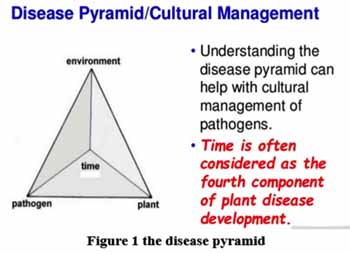
The seminar was dominated by the ‘disease pyramid’, which helps illustrate the four interacting factors which impact the level of disease incidence: pathogen, environment, plant and time. Turf managers were encouraged to focus on areas they can successfully influence in order to reduce disease levels, with factors such as nutrient inputs, cultural tasks and defence activators being assessed in detail. The seminar presented solid scientific data to support the efficacy of traditional and novel ways to reduce disease levels.
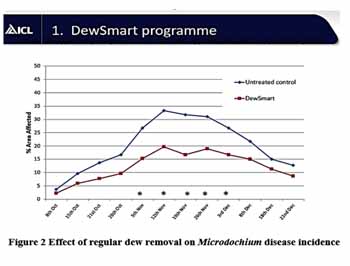
The first point on the disease pyramid is the pathogen. Turf professionals in the UK and Ireland are only too familiar with the symptoms and appearance of Microdochium patch and Anthracnose. These pathogens are ever present in the growth media and will infect turfgrasses when conditions are suitable. Studies of the infection processes of these pathogens can be used to target areas to help reduce infection. Research shows that hyphae and conidia in the soil / thatch are the main source of inoculum. When environmental conditions are suitable, infection commences with mycelium growing up the base of the plant, target environmental conditions suitable for infection. With Anthracnose, infection is by means of formation of penetration structures (appressoria) on the leaf, which then penetrate the plant via the cuticle, strengthen cuticle cell walls. Microdochium infection is via stomatal penetration. Both pathogens will then travel through intercellular spaces and extract nutrients from cells, strengthen cell walls. The final phase of infection sees the pathogens exiting and producing reproductive structures which are then dispersed and the cycle of infection can then repeat. What can be done to reduce disease is: to reduce environmental conditions conducive for infection, utilise whichever nutritional, cultural and biological methods available to aid the plant in its defence and response to infection. Infected plants do not sit back and allow pathogens to infect without responding. Biotically challenged plants will respond with a complex interaction of chemical defence compounds and these can be stimulated or enhanced by turfgrass managers.
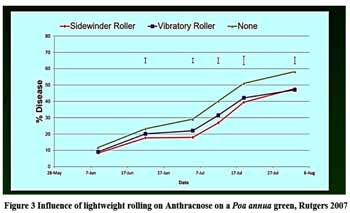
The second point of the disease pyramid is the environment. Environmental factors such as surface moisture, ambient temperatures, humidity, poor air movement and light quality play a significant part in disease development. Of these, surface moisture in the form of dew or guttation fluid is a critical factor for Microdochium infection as it provides an ideal medium for fungal growth. A recent study by the STRI clearly shows the value of dew reduction on disease levels, with significant suppression of incidence during times of high disease pressure.
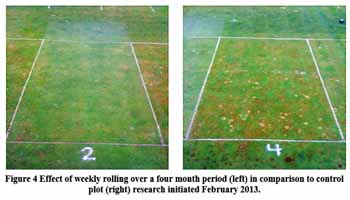
Cultural practices such as rolling, sand topdressing and mowing height can also influence disease incidence and severity. For example, lightweight rolling is a regular feature of greens’ management, carried out primarily to increase speed and improve surface smoothness. However rolling, as shown in research carried out at Rutgers and Oregon State Universities in the US, has secondary benefits of reducing both Anthracnose and Microdochium disease incidence. The figures here show how lightweight rolling can significantly reduce both these diseases, it should be noted that the results reflect the direct action of rolling on dry turf surfaces, so dew removal was not a factor. Light frequent sand topdressing and a change of mowing height of cut from 2.8mm to 3.6mm reduces Anthracnose incidence, this combination of rolling, topdressing and increased height of cut can have a significant effect on Anthracnose pressure without sacrificing surface playing qualities.
The plant factor is the third part of the disease pyramid and forms a critical role in disease levels. Turfgrass species and cultivars which form the sward will have a significant impact on disease levels. Annual meadow grass (Poa annua) is widespread and dominates many golf greens throughout the UK and Ireland. This species is highly susceptible to both pathogens and many turf managers are increasingly adapting their cultural and nutritional programmes to favour the ingress of less susceptible turfgrass such as Agrostis spp. and Festuca. A number of turf managers are also going down the road of total species conversion, which is the elimination of Poa from the greens to be replaced by either Agrostis or Festuca. This can be a difficult path which requires the full understanding and backing of members and committees.
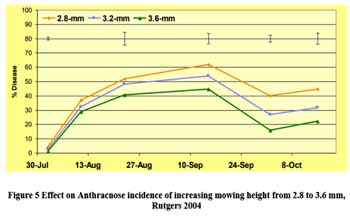
Plant nutrition. The nutritional status of the sward can have a direct effect on disease incidence and a nutritional balance is the key for healthy turfgrass. Excessively high or low fertility contributes to disease pressures. However, the seminar did not focus on nutritional programmes, but rather on the fact that eight of the 13 essential nutritional elements have a direct influence on disease development. A number of these elements were highlighted and data shown to illustrate this direct effect on disease incidence. Just two are mentioned here, ferrous sulphate for example, has been used by generations of greenkeepers to combat Microdochium infection, but until recently there were no data to support its use. Studies at Myerscough College in Lancashire and at the STRI determined a robust scientific basis for suppression of this disease.
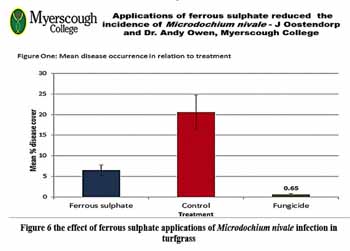
Silica is used by turf managers to increase turgidity and green speed but can, when applied as a foliar treatment, strengthen plant cell walls. As stated above Anthracnose infection is via penetration of the outer cuticle and both Anthracnose and Microdochium need to enter the inner cells, and as shown here, strengthening these cells by Silica can help slow the infection process.
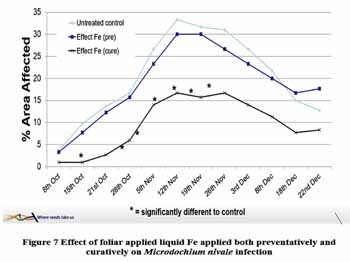
Probably the most intriguing factor on the disease pyramid was the time element. This does not refer to the time of day or even time of year. It involves the time it takes for the pathogen to germinate, to grow and the time it takes to infect the plant. It also refers to the time it takes the plant to recognise it is being infected and the time then for the plant to respond with its biochemical defences. Plants when under attack will respond with a complex array of interconnected defence strategies. Important steps in this defence response are: recognition of the invading pathogen, production of short term defence compounds such as hydrogen peroxide and phenolic compounds, and then generation of signalling compounds which can travel through the plant priming it for further attack. The question for turf managers was, can these defences be stimulated of enhanced? The answer was yes, there are numerous methods or compounds which can be used for this purpose. Phosphite is a prime example of a ‘defence activator’. There is now strong evidence, as can be seen above, that phosphite treatment will reduce disease incidence. Its mode of action is complex and two-fold. Phosphite acts as a fungistat, slowing the pathogens growth in the plant, thus allowing it increased time to respond. Secondly it has been shown that phosphite will directly stimulate production of defence-related compounds prior to infection and that treated plants will have a faster response time when under attack.
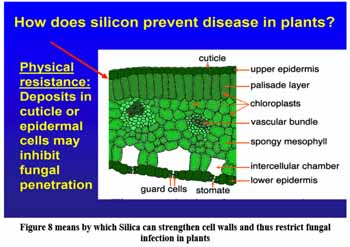
The take home points from this seminar were that turf managers need to focus on the factors that can successfully influence reduced disease levels. Environmental factors such as dew removal can have a significant effect. Plant factors include the use of less susceptible turfgrass species and cultivars, balanced nutrient inputs and the judicious use of elements or compounds which have a positive effect on disease suppression. The inclusion in maintenance programmes of cultural practices such as lightweight rolling, sand topdressing and mowing practices which incorporate optimum heights of cut will lessen disease pressure. And the use of defence activators will allow the plant to respond effectively and in a timely natural manner.
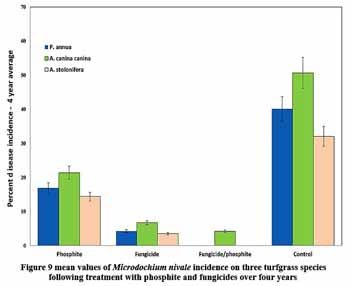
None of these practices alone will fully eliminate disease! Hopefully you will be able to incorporate some into your maintenance programmes. They will help to reduce disease incidence and help reduce reliance on fungicides. Some will also enhance your fungicide programmes.

The seminar ‘Turfgrass Disease – Alternative Means of Suppression’ was presented during Continue to Learn, at BTME 2018.
Dr John Dempsey, PhD BSc (Hons), has been the course manager at Royal Curragh Golf Club, Ireland’s oldest golf club, since 1993. He has a first class honours degree in turfgrass science from Myerscough College and a PhD in turfgrass pathology at the University of the West of England’s Centre for Research in Biosciences















Let me tell You a sad story ! There are no comments yet, but You can be first one to comment this article.
Write a comment